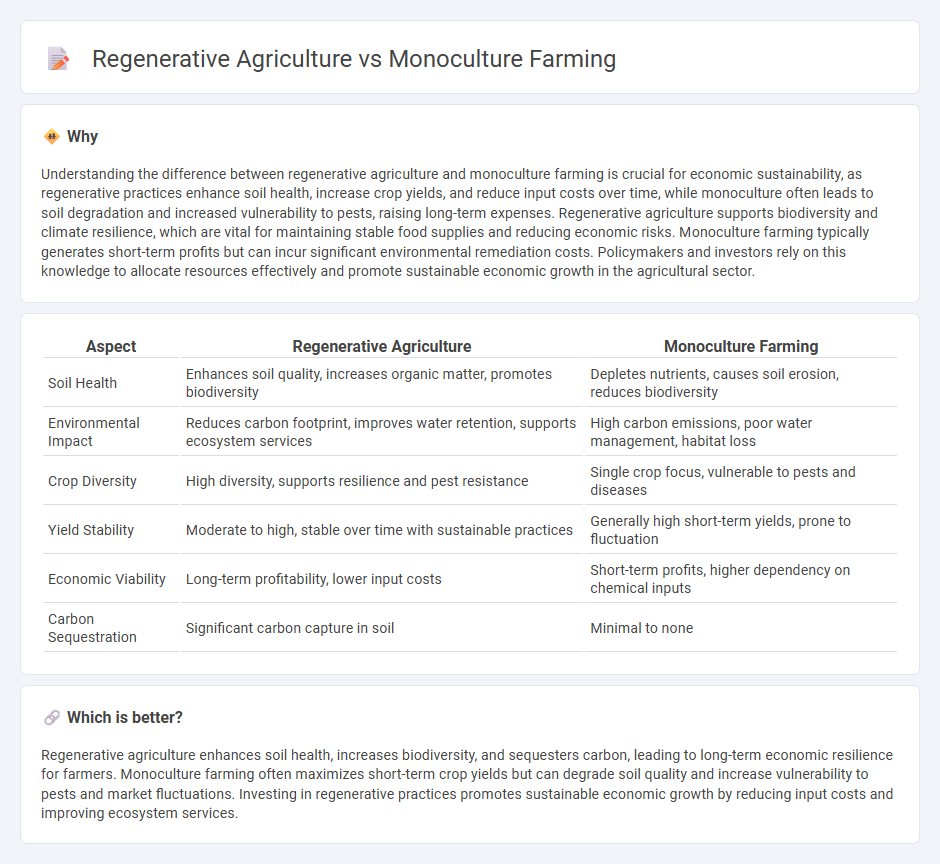
Regenerative agriculture enhances soil health, increases biodiversity, and boosts long-term farm productivity by using crop rotation, cover crops, and reduced tillage methods. In contrast, monoculture farming prioritizes single-crop production, leading to soil degradation, increased vulnerability to pests, and dependence on synthetic inputs. Discover how shifting to regenerative practices can transform agricultural economies and promote sustainability.
Why it is important
Understanding the difference between regenerative agriculture and monoculture farming is crucial for economic sustainability, as regenerative practices enhance soil health, increase crop yields, and reduce input costs over time, while monoculture often leads to soil degradation and increased vulnerability to pests, raising long-term expenses. Regenerative agriculture supports biodiversity and climate resilience, which are vital for maintaining stable food supplies and reducing economic risks. Monoculture farming typically generates short-term profits but can incur significant environmental remediation costs. Policymakers and investors rely on this knowledge to allocate resources effectively and promote sustainable economic growth in the agricultural sector.
Comparison Table
| Aspect | Regenerative Agriculture | Monoculture Farming |
|---|---|---|
| Soil Health | Enhances soil quality, increases organic matter, promotes biodiversity | Depletes nutrients, causes soil erosion, reduces biodiversity |
| Environmental Impact | Reduces carbon footprint, improves water retention, supports ecosystem services | High carbon emissions, poor water management, habitat loss |
| Crop Diversity | High diversity, supports resilience and pest resistance | Single crop focus, vulnerable to pests and diseases |
| Yield Stability | Moderate to high, stable over time with sustainable practices | Generally high short-term yields, prone to fluctuation |
| Economic Viability | Long-term profitability, lower input costs | Short-term profits, higher dependency on chemical inputs |
| Carbon Sequestration | Significant carbon capture in soil | Minimal to none |
Which is better?
Regenerative agriculture enhances soil health, increases biodiversity, and sequesters carbon, leading to long-term economic resilience for farmers. Monoculture farming often maximizes short-term crop yields but can degrade soil quality and increase vulnerability to pests and market fluctuations. Investing in regenerative practices promotes sustainable economic growth by reducing input costs and improving ecosystem services.
Connection
Regenerative agriculture and monoculture farming are connected through their impact on soil health and biodiversity; regenerative practices enhance soil carbon sequestration and restore ecosystems, while monoculture depletes nutrients and increases vulnerability to pests. The economic implications include higher long-term costs for monoculture systems due to fertilizer and pesticide dependence, contrasted with regenerative methods that improve farm resilience and reduce input costs. Market demand for sustainably produced goods is driving investment toward regenerative agriculture, influencing agricultural policies and supply chain economics.
Key Terms
Productivity
Monoculture farming often achieves high short-term crop yields by growing a single crop species over large areas, but it can lead to soil degradation and reduced long-term productivity. Regenerative agriculture emphasizes restoring soil health and biodiversity, which enhances nutrient cycling and resilience, potentially increasing sustainable productivity over time. Explore how these farming methods impact agricultural output and environmental sustainability in detail.
Sustainability
Monoculture farming relies on growing a single crop species repeatedly, leading to soil degradation, reduced biodiversity, and increased vulnerability to pests and diseases, which undermines long-term sustainability. Regenerative agriculture emphasizes crop diversity, soil health restoration, and ecosystem balance, promoting carbon sequestration and resilient food systems. Explore the benefits of regenerative practices to advance sustainable agriculture and combat environmental challenges.
Externalities
Monoculture farming often leads to negative externalities such as soil degradation, loss of biodiversity, and increased greenhouse gas emissions due to heavy reliance on chemical inputs and lack of crop diversity. In contrast, regenerative agriculture enhances ecosystem services by improving soil health, sequestering carbon, and promoting biodiversity, mitigating many environmental costs associated with conventional farming. Explore the benefits and trade-offs of these practices to understand their full impact on environmental and economic externalities.
Source and External Links
The rise and fall of monoculture farming | Horizon Magazine - Monoculture farming involves growing a single crop species in a field to increase machinery efficiency, but it risks disease outbreaks, requires more pesticides, degrades soil by nutrient depletion, and increases fossil fuel use and greenhouse gas emissions.
What Monoculture Farming Is, and Why It Matters - Sentient Media - Monoculture farms grow one crop type per area for efficiency and lower costs, covering about 80% of agricultural land, but degrade soil and require increased fertilizer use, threatening long-term sustainability.
Monoculture Farming Explained: What Are The Pros And Cons? - Monoculture disrupts soil balance by depleting nutrients and soil biodiversity, leading to soil erosion and increased chemical fertilizer use that harms ecosystems and contributes to soil exhaustion over time.
 dowidth.com
dowidth.com